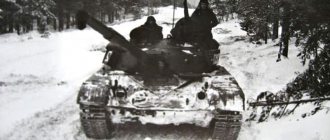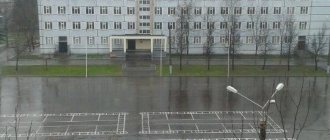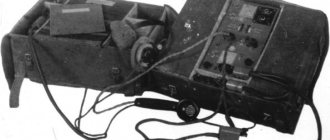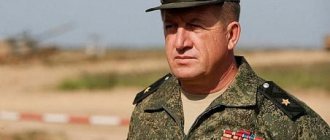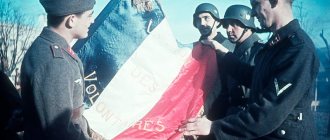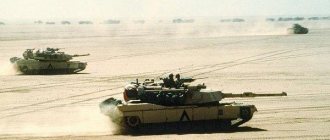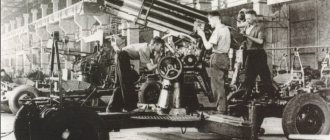Formed in March 1941. in KOVO as part of 16MK (divisional commander Alexander Dmitrievich Sokolov).
The 15th Tank Division was formed as part of the 8th Mechanized Corps in the summer of 1940. It was created on the basis of the 14th Heavy Tank Brigade, as well as the 512th Infantry and 486th Howitzer Artillery Regiments, the 443rd Tank Battalion of the 146th 1st Rifle Division, Tank Regiment, Zenart Division of the 16th Cavalry Division. The division had a significant fleet of light tanks, as well as 75 T-28 medium tanks, which it inherited from the 14th Brigade. The second tank battalions of the division's regiments were armed with light armored vehicles.
The 16th Mechanized Corps was one of the first-line combat units. The number of personnel at the beginning of the war was 26,380 people, which accounted for 73% of the staff. By June 1941, the corps's complement of tanks, tractors and vehicles was less than half of its regular strength. There were no more than 30% of serviceable tanks. Re-equipment to new KV and T-34 sneakers was planned to be carried out during 1941, as the vehicles were received from factories. Unfortunately, the corps did not receive KV and T-34 tanks at the beginning of the war.
On June 22, 1941 The division is part of the 16MK in KOVO and is stationed in Chernivtsi.
16MK moved to the concentration areas at 9 a.m. on June 22, 1941. The 15th Tank Division left Stanislav to the area of Toporovtsi, Boyan, Kotsman.
| Availability of equipment in 16MK on June 22, 1941 | ||||||
| T-28 | BT | T-26 | HT | Total tanks: | BA | |
| 15td | 75 | ? | ? | ? | 347 | 34 |
| 39td | — | — | 196 | 13 | 209 | 5 |
| 240md | ? | ? | ? | ? | 112 | ? |
| Total: | 75 | 360 | 214 | 31 | 680 | 157 |
By the morning of June 23, the tank divisions had basically completed their concentration in the areas assigned to them, placing the headquarters of the formations: the 15th tank division in Kuchurmik, the 39th tank division in Chakhor. The corps headquarters moved to Kotsman. 240th Motorized Division Grembochek, Novoselka. Until June 27, the position of the 16th Mechanized Corps did not undergo significant changes.
From 00:05 on June 25, 1941, by order of Headquarters, the 16th Mechanized Corps in its entirety was transferred to the 18th Army, the command of which was deployed on the base of the Kharkov Military District and arrived in Kamenets-Podolsky on June 26, 1941. However, the actual transfer of the formation from one army to another took place only on June 27. The new army command generally confirmed the deployment of corps units and its main tasks - to prepare for counterattacks against the invading enemy.
The next four days of the war also did not bring any changes to the deployment of the corps. The formation was perhaps the only mechanized corps of the border armies that did not fully participate in border battles for such a long time. This is partly explained not even by the complexity of the operational situation in the zone of the 12th Army (the infantry divisions here coped with the enemy onslaught on their own), but by the leapfrog in the leadership of the troops. Nominally, the Southwestern Front was deprived of the right to control the corps already from the end of June 24, and the newly formed Southern Front and the headquarters of the 18th Army took control of the corps only by the end of June 27 - and the latter still needed a certain amount of time to study the situation and make the right decisions. The anticipation of the Germans’ advance in the 18th Army’s zone to the north, in order to create a cauldron in the Lvov ledge, also played a role. The 16th Mechanized Corps held out, among other things, to provide cover from this danger.
During this time, the corps' formations fundamentally changed their deployments, preparing for battles, but being on the periphery of the main battles of the war that had begun. Only on June 30 did the command of the Southern Front decide to withdraw its right flank, which was occupied by the 18th Army. The next day, army headquarters presented a withdrawal plan, according to which the 16th Mechanized Corps formed the reserve of the 18th Army and was withdrawn to the Balin, Dunaevtsy area.
The withdrawal of troops of the 16th Mechanized Corps across the Dniester River began on July 2, 1941. In order to avoid enemy reconnaissance discovering the movement and causing air strikes on the columns, the withdrawal was carried out in two night marches. By the morning of July 3, the 15th Panzer Division, having crossed the Dniester in Zalishchiki, concentrated in the Cherch, Lyantskorup area. During the night of July 4, 1941, the formations made another transition and concentrated: the 15th Division - the area east of Balin, Zalestsy. The corps headquarters was located in Dunaevtsy.
On July 4, 1941, the 16th Mechanized Corps, by order of Headquarters, left the Southern Front. In accordance with the plans of the Soviet command, a fairly powerful group was created in the Mozyr, Kalinkovichi, Khoiniki area, which was to include one rifle and one mountain rifle division from the previous composition of the 19th Army, the 5th cavalry and several artillery regiments, the rifle corps control from of the Southwestern Front, as well as the 16th Mechanized Corps and the 32nd Cavalry Division from the Southern Front.
In accordance with the directive of the Chief of the General Staff of the Red Army, Army General G.K. Zhukov, the 16th Mechanized Corps was to be transferred to Mozyr no later than July 9, 1941 using a combined method. The tracked equipment was sent by rail from the stations Derazhnya and Zhmerinka. The start of loading was scheduled for 12 o'clock on July 6. The wheeled equipment with transportable supplies and motorized infantry personnel was sent to the concentration area at full speed along the route Vinnitsa, Zhitomir, Korosten, Mozyr. The section south of Korosten had to be passed no later than 20:00 on July 9.
This order did not correspond to the actual technical condition of the formations of the 16th Mechanized Corps. The divisions had to travel from 65 to 100 kilometers just to the loading points and railway echelons of the worn-out materiel. Taking into account previous marches, for the 15th Panzer Division after leaving its deployment sites in Stanislav before loading in Derazhnya, the total approximate vehicle mileage was 270-300 kilometers. On the division's routes there remained equipment that was out of order due to technical reasons. And at the same time, the formation has not yet participated in a single battle! By July 9, 1941, the corps (without the 39th Panzer Division) had only about two hundred serviceable tanks left.
July 9, 1941 The 39td was withdrawn from the corps, and in return the 44td from the 18th mechanized corps was included.
The unreality of G.K.’s order Zhukov's announcement about the start of loading parts of the hull at 12 o'clock on July 6, 1941 became obvious almost immediately. The 15th Tank Division concentrated at the Derazhnya station only by the morning of July 7, 1941, but due to a lack of rolling stock, it sent its units until July 11. The 240th Motorized Division with a limited number of vehicles arrived at the Zhmerinka loading station only towards the end of July 8th. This situation led to the fact that the hull connections were split into echelons, and the echelons were mixed along the way. In addition, we should not forget that the automobile echelon of the corps was moving on a separate route to Mozyr. Motorized infantry, tanks, artillery, ammunition supplies - everything moved separately from each other, getting mixed up with other troops moving along the railway or highway. The mechanized corps found itself helpless in the face of the imminent tests.
On the evening of July 7, the enemy with the forces of the 11th Tank Division broke through to Berdichev and occupied the city. The commander of the 16th Mechanized Corps, Sokolov, traveling that day by car to the place of the new deployment, in Kazatin, learned about the occupation of Berdichev by German sneakers and motorized infantry. Sokolov immediately contacted the commander of the Southwestern Front and, having received the appropriate sanction, began to subjugate all the troops located in this direction. This is how the “Group of Forces of Divisional Commander Sokolov” arose.
At night, Divisional Commander Sokolov regrouped the forces of his group and set the task of attacking Berdichev again. A detachment of the 10th Panzer Division was supposed to attack in the direction of Zhezhelevo, Khazhin with the task of capturing the southeastern outskirts of the city. Units of the 44th Tank Division attacked the city from the southwest, from the direction of Raigorodok. At 6:00, Soviet aviation raided the positions of the defending Germans and columns of reinforcements approaching Berdichev, while artillery shelled the city, after which tanks and infantry went into battle.
On July 9, Sokolov’s group, which at that time consisted mainly of units 44 and 10td, launched an attack on Berdichev. We managed to break into the outskirts of the city, but failed to drive the enemy out of Berdichev. Having brought up their reserves, the German units of Kruevel's 11th Division launched counterattacks. Having suffered heavy losses, parts of Sokolov’s group retreated from the city. New units of the 16th Mechanized Corps arrived to replace the units of Sokolov’s group that had suffered losses. By the morning of July 10, the reconnaissance battalion of the 15th Tank Division, as well as part of the artillery of the 15th and 44th divisions, arrived in the battle area. One of the tank regiments of the 15th Tank Division on the morning of July 10, 1941 unloaded in Kalinovka, 45 kilometers from the battle site. The arriving headquarters of the 16th Mechanized Corps was located at the edge of the forest on the northeastern outskirts of Raigorodok.
Attacks on the city continued on July 11. The front commander decided to redirect the main efforts of the right flank of the 6th Army from frontal attacks on Berdichev to intercept the communications of the enemy Berdichev group. However, on July 11, the situation on the left flank of Sokolov’s group became sharply complicated. The remnants of the 4th mechanized and 49th state rifle corps, having suffered heavy losses and lost their combat effectiveness, retreated to Yanushpol, exposing the flank of the 16th mechanized corps. In addition, the enemy increased pressure in the direction of Kazatin. All this forced the Soviet command to once again direct its efforts to Berdichev to neutralize the enemy entrenched there. In the Markushi and Khazhin sector, a tank regiment of the 15th Tank Division was brought into battle, reinforcing the tired units of the 87th Tank Regiment of the 44th Tank Division. These units successfully advanced in the direction of Bystrika and reached the southwestern outskirts of Berdichev, from where the Germans opened heavy fire from their anti-tank guns. The tank crews were unable to achieve more, due to enemy airstrikes and weak communications at all levels of the division-regiment-battalion structure, and as a result, poor coordination of the units.
On July 12, the enemy went on the offensive from Berdichev. The 15th Panzer Division, consisting of two battalions of the 30th Tank Regiment and one battalion of the 29th Tank Regiment, concentrated in the area of Puzyrki, Vel by 18:00. Godomtsy, having the task of attacking the enemy in the direction of Semenovka, Vel. Nizhogurians. The 240th motorized division (836th and 842nd motorized regiments, the latter without a battalion) entered the same area, intending to attack Berdichev from the east. But the command of the group, units of the 15th Tank Division were again withdrawn from Berdichev, since the enemy, having captured Raigorodok, began to really threaten the flank and rear of the Soviet troops storming the city. The remnants of the 4th Mechanized, 36th and 49th Rifle Corps, operating to the left of Sokolov’s group, exhausted their combat capabilities and began to retreat to the southeast. Capturing Berdichev lost its operational meaning.
On July 13, 15td consisted of: 45 T-28, 32 BT5/7, 15 T-38.
On July 13, the main forces of Divisional Commander Sokolov’s group, under enemy pressure, withdrew from the Velikiye Pizhgurtsy, Ivankovtsy, Khazhin line. On July 15, the enemy occupied an important communications hub - Kazatin. There was a huge gap between the 6th and 5th armies of the Southwestern Front. The enemy XIVMK units rushed into this breakthrough, bypassing the 16th mechanized corps on the right flank.
With a breakthrough to Kozatin, the enemy cut Sokolov’s group into two parts. Near the village of Komsomolskoye, a battalion of the 15th Tank Division was surrounded. With a night breakthrough, the battalion managed to reach its own. In the area of the village of Ldamovka, the 87th Tank Regiment was surrounded. The regiment had 18 tanks left and 5-6 shells per tank gun. The corps commander organized a relief detachment, which included six BT tanks, one T-37, three armored vehicles, two anti-tank batteries and a rifle battalion with six guns. The detachment was headed by Corps Commissioner Sergeev. A night attack from both sides managed to bring those surrounded out of the ring. To preserve the combat effectiveness and integrity of the front, units of the 16th Mechanized Corps with attached units and combined detachments slowly retreated to Zarudintsy and Ruzhin. In the Ruzhin area, the commander of the 30th tank regiment of the 15th tank division, who was covering the group’s retreat, Lieutenant Colonel Nikitin, was killed. He was buried in Khristinovka. Command of the regiment was taken over by the chief of staff, Major Miropenko. There were heavy losses in material terms. As of July 17, the corps had only 73 tanks and 16 armored vehicles, there were 903 wheeled and auxiliary vehicles, of which 29 were passenger cars, 620 GAZ trucks, 304 ZIS trucks, 50 tractors. At that moment the corps was a weak motorized rifle division.
By the end of July 18, Sokolov’s group (16th MK, 15th Tank Division, 240th Motorized Rifle Division, 3rd Ptabry) occupied the defensive line of Leshchiitsa, Gorodok, Nemiritsy. The group's headquarters was in Soskovka. Continuing to hold back the enemy in this area with their rearguards, on July 20 the corps retreated to the Krupodsrentsy area. On July 19, the 173rd Infantry Division (Major General S.V. Verzii) was subordinated to Divisional Commander Sokolov; on the morning of July 20, it launched an attack on Kuryantsy, fighting in the area of Ros station. The corps experienced serious interruptions in the supply of fuel and ammunition.
On July 22, corps formations repelled enemy attacks from the Adamovka and Vasylkivtsi areas. On July 23, Divisional Commander Sokolov received a combat order from the commander of the 6th Army, which tasked the corps with immediately starting a retreat and by 6 am on July 24 to occupy and strengthen the line (claim) Staro-Zhivotov, Poponka, Verbovka, Skala, (claim) Kozhanka. There were no troops to the right of the 16th Mechanized Corps. According to the front report on July 22, the 15th Division consisted of 8 tanks and 16 guns. Ogurtsov’s group (remaining 10th Panzer Division) and Colonel Fotchenkov’s group (remains of the 8th Tank Division) and a detachment of the 44th Panzer Division fought nearby. At this time, by order of the command, the most chain tank cadres, who did not have any material and were used in battles as ordinary infantry, were recalled from the front. Reformation took place in the corps units: the remaining military equipment was transferred to consolidated detachments, the personnel of the tank units departed to the Pogrebishche area, and then to Monastyrische, where they were loaded into echelons and departed to factories to receive new military equipment. The remnants of the 15th Division were leaving for Stalingrad. As a result, the 16th Mechanized Corps turned into a small infantry detachment with several tanks. The command of the divisions withdrawn to the rear remained in the corps and at the headquarters of the 6th Army.
In a report from the headquarters of the 6th Army dated July 26, 1941, Fr. By July 31, only 5 T-28 tanks and 11 BA-10,1 BA-20 armored vehicles remained in the 16th Mechanized Corps.
On July 30, the enemy occupied Khristinovka station. The 16th Mechanized Corps tried to recapture the station.
On July 31, the expelled liaison delegate of the 37th Rifle Corps did not find the 16th MK at the previous line of defense in the Kocherzhintsy area.
On August 1, corps units passed through Uman, where abandoned trains with ammunition and fuel stood at the station. On this day, units of the 9th Division XIVMK and the 1st State Division XXXXIXAK united, encircling the remnants of the 6th and 12th armies south of Uman.
On August 2, by order of the commander of the 6th Army, he occupied the line (claim) Svinarka, Korzhovy Kut, (claim) Dubovo. The corps headquarters was located on the southern outskirts of Oksanino.
On August 4, Divisional Commander Sokolov tries to organize a breakthrough to Pervomaisk to connect with units of the 18th Army. On August 5, the remnants of the corps fought heavy battles between the Yatran and Sinyukha rivers, trying to expand the bridgehead from Peregonovka to N. Arkhangelsk. On August 5, the commander of one of the corps' tank groups, Colonel Fotchenkov, recaptured two tanks from the Germans and was able to refuel 6 of his tanks. Divisional Commander Sokolov had high hopes for these tanks during the breakthrough planned on the night of August 5-6. The last 8 T-26 tanks of the 15th Tank Division stood near the church in the village of Podvysokoye without ammunition and without a drop of fuel.
On the evening of August 5, from the remaining units and formations of the 16th and 4th mechanized and 37th rifle corps, division commander Sokolov forms a breakthrough group. The remnants of the 15th Division were supposed to break through together with At 23 o'clock the breakthrough group begins to move towards the Yatran River. There are up to six thousand people in the group, armed with light machine guns, rifles, pistols, hand grenades, and a dozen horse-drawn light guns. Colonel Fotchenkov's detachment with tanks did not arrive for an unknown reason.
The first enemy barrier between Pokatilovo and Lebedinka was knocked down by a bayonet attack. As stipulated by the order, General Tonkonogov’s group went to the Emilovsky forest, and Colonel Krymov’s group, having destroyed the Germans in Troyanka, moved to Shepilovo. Sokolov's group walked in the center. At 12 o'clock the groups of Sokolov and Tonkonogov began a battle for Emilovka. By two o'clock the village was taken. By this time, several people from Krymov’s group had made their way to Sokolov, reporting the death of the group and its commander. The remnants of the breakthrough group occupy Novoselka. The wounded were left here and a message was received about the death of General Tonkonogov. Sokolov’s group goes to the Sinyukha River south of the village of Olyshka. Those who crossed the river are met on the other side by a German detachment with tanks. Here Divisional Commander Sokolov took his last battle, was wounded several times, was captured in critical condition, where he died.
Only a group led by the commander and commissar of the 15th Tank Division, Colonel Polozkov and regimental commissar Romanenko, was able to break out of the encirclement. She went out to her people on September 28 in the Bryansk forests. The evacuated personnel of the corps divisions in August - September 1941 were turned to the formation of tank brigades, which received new military equipment. From the tankers of the 15th Tank Division in Stalingrad, the 4th Tank Brigade was formed (Colonel M.E. Katukov); at the end of 1941, for military services in the Battle of Moscow, it was transformed into the 1st Guards.
Colonel Polozkov, after leaving the encirclement, was a liaison officer on the Western Front, and then commanded a number of tank formations. Died as commander of 18TK near Bucharest in 1944.
Recommendations:
this book was recommended by 0 users. Think carefully
before recommending a book . A recommendation is the highest rating you can give a book. 10 on a 5-point scale.
Linguistic text analysis:
Approximately pages: 503 pages - a lot (234) Average sentence length: 128.24 characters - much above average (82) Active vocabulary:
close to average
1388.98 unique words per 3000 words of text Share of dialogue in the text: 0.00% - very little (26 %) Detailed text analysis >>
Literature
- Feskov V.I., Golikov V.I., Kalashnikov K.A., Slugin S.A.
The Armed Forces of the USSR after the Second World War: from the Red Army to the Soviet. Part 1: Ground forces. - Tomsk: Tomsk University Publishing House, 2013. - 640 p. — ISBN 978-5-89503-530-6. - Bagautdinov Airat Maratovich, Bagautdinov Ruslan Airatovich. Debaltsevo raid of the 7th Guards Cavalry Corps. Chronicle of battles in Wehrmacht documents. Monograph. - Ufa. RIC BashSU. 2020. −172 p. ISBN 978-5-7477-5170-5
- Bagautdinov A. M., Bagautdinov R. A.
The last battle of the guard of Major General M. M. Shaimuratov. — Collection of German documents. - Ufa: Bashkir State University, 2022. - P. 278 pp. ISBN 978-5-7477-5075-3.
Subordination
| date | Front (district) | Army | Frame | Notes |
| 02/14/1943 | Southwestern Front | 5th Tank Army | 7th Guards Cavalry Corps | — |
| 03/01/1943 | Southwestern Front | — | 7th Guards Cavalry Corps | — |
| 04/01/1943 | Southwestern Front | — | 7th Guards Cavalry Corps | — |
| 05/01/1943 | Southwestern Front | — | 7th Guards Cavalry Corps | — |
| 01.06. 1943 | Reserve Headquarters of the Supreme High Command | — | 7th Guards Cavalry Corps | Steppe Military District |
| 01.07. 1943 | Reserve Headquarters of the Supreme High Command | — | 7th Guards Cavalry Corps | Steppe Military District |
| 08/01/1943 | Reserve Headquarters of the Supreme High Command | — | 7th Guards Cavalry Corps | — |
| 09/01/1943 | Reserve Headquarters of the Supreme High Command | — | 7th Guards Cavalry Corps | — |
| 01.10.1943 | Central Front | 61st Army | 7th Guards Cavalry Corps | — |
| 01.11.1943 | Belorussian Front | 65th Army | 7th Guards Cavalry Corps | — |
| 12/01/1943 | Belorussian Front | — | 7th Guards Cavalry Corps | — |
| 01/01/1944 | Belorussian Front | 61st Army | 7th Guards Cavalry Corps | — |
| 02/01/1944 | Belorussian Front | 61st Army | 7th Guards Cavalry Corps | — |
| 03/01/1944 | 2nd Belorussian Front | — | 7th Guards Cavalry Corps | — |
| 04/01/1944 | 2nd Belorussian Front | — | 7th Guards Cavalry Corps | — |
| 05/01/1944 | 1st Belorussian Front | 69th Army | 7th Guards Cavalry Corps | — |
| 06/01/1944 | 1st Belorussian Front | — | 7th Guards Cavalry Corps | — |
| 07/01/1944 | 1st Belorussian Front | — | 7th Guards Cavalry Corps | — |
| 08/01/1944 | 1st Belorussian Front | — | — | |
| 09/01/1944 | 1st Belorussian Front | — | 7th Guards Cavalry Corps | — |
| 01.10.1944 | 1st Belorussian Front | — | — | |
| 01.11.1944 | 1st Belorussian Front | — | 7th Guards Cavalry Corps | — |
| 12/01/1944 | 1st Belorussian Front | — | 7th Guards Cavalry Corps | — |
| 01/01/1945 | 1st Belorussian Front | — | 7th Guards Cavalry Corps | — |
| 02/01/1945 | 1st Belorussian Front | — | 7th Guards Cavalry Corps | — |
| 03/01/1945 | 1st Belorussian Front | — | 7th Guards Cavalry Corps | — |
| 04/01/1945 | 1st Belorussian Front | — | 7th Guards Cavalry Corps | — |
| 05/01/1945 | 1st Belorussian Front | — | 7th Guards Cavalry Corps | — |
[12]
Compound
1945
The new numbering of the division's units was assigned on March 14, 1943.
- 53rd Guards Cavalry Regiment;
- 55th Guards Cavalry Regiment;
- 57th Guards Cavalry Regiment;
- 57th separate tank regiment (from March 25, 1944);
- 147th Guards Artillery and Mortar Regiment (59th Separate Cavalry Artillery Division);
- 19th separate guards air defense division (anti-aircraft battery);
- 147th Guards Artillery Park;
- 55th separate reconnaissance squadron;
- 16th separate guards sapper squadron;
- 14th separate guards communications squadron;
- 11th separate medical squadron;
- 17th separate guards chemical defense platoon (15th separate guards chemical defense squadron);
- 135th Food Transport;
- 18th platoon for the supply of fuels and lubricants;
- 16th divisional veterinary hospital;
- 311th Field Postal Station;
- 986th field cash desk of the State Bank of the USSR.
[10]
1988
- Department (Milovice)
- 29th Guards Tank Idritsky Red Banner Regiment (Milovice);
- 239th Guards Tank Vitebsk Order of Suvorov Regiment (Milovice);
- 244th Guards Tank Lodz Red Banner, Orders of Suvorov and Kutuzov Regiment (Milowice);
- 295th Guards Motorized Rifle Red Banner, Orders of Suvorov, Kutuzov, Alexander Nevsky Regiment (Milovice);
- 914th self-propelled artillery Kiev twice Red Banner orders of Suvorov, Kutuzov, Bogdan Khmelnitsky regiment (Trutnov);
- 282nd Anti-Aircraft Missile Bialystok Red Banner Regiment (Lazne Bogdanec);
- 535th separate missile division (Zdechovice);
- 81st separate reconnaissance battalion (Milovice);
- 215th separate guards communications battalion (Milovice);
- 152nd Separate Guards Engineer Battalion (Zdechovice);
- 517th separate chemical defense battalion (Milovice);
- 142nd separate repair and restoration battalion (Milovice);
- 119th separate medical battalion (Milovice);
- 910th separate logistics battalion (Milovice).[11]
Awards and honorary titles
- “Guards” - an honorary title awarded by order of the People's Commissar of Defense of the USSR No. 78 dated February 14, 1943 for courage shown in battles for the Fatherland against the German invaders, for steadfastness, courage, discipline and organization, for the heroism of personnel;
- “Mozyrskaya” - the honorary name was assigned by order of the Supreme Commander-in-Chief No. 07 of January 15, 1944 to commemorate the victory and distinction in the battles with the German invaders for the liberation of the cities of Mozyr and Kalinkovichi;
- Order of the Red Banner - awarded by the Decree of the Presidium of the Supreme Soviet of the USSR dated August 9, 1944 for the exemplary performance of combat missions of the command on the front of the fight against the German invaders, for the capture of the city of Lublin and the valor and courage shown at the same time;
- Order of Suvorov, 2nd degree - awarded by Decree of the Presidium of the Supreme Soviet of the USSR on February 19, 1945 for exemplary performance of command tasks in battles with German invaders, for the capture of the cities of Sochaczew, Skierniewice, Lowicz and the valor and courage shown at the same time [3]
Awards of division units;
- 53rd Guards Cavalry Lodz[4] Red Banner[5] Orders of Suvorov[6] and Kutuzov[7] Regiment;
- 55th Guards Cavalry Red Banner[5] Orders of Suvorov[8], Kutuzov[7] and Alexander Nevsky[6] Regiment;
- 57th Guards Cavalry Pomeranian[9] Red Banner[5] Orders of Suvorov[7] and Kutuzov[8] Regiment;
- 57th Tank Lodz[4] Red Banner[5] Orders of Suvorov[7] and Kutuzov[6] Regiment;
- 147th Guards Artillery and Mortar Lodz[4] Red Banner[5] Order of Bohdan Khmelnitsky[6] (awarded the Order of Bohdan Khmelnitsky, II degree) and Suvorov[7] Regiment;
- 16th separate guards sapper order of Alexander Nevsky[6] and Red Star[8] squadron;
- 14th separate guards orders of Alexander Nevsky[6] and Red Star[8] communications squadron;
Commanders [edit]
Division commanders: [4]
- Lieutenant General Friedrich Kühn (November 1940 - March 21, 1941)
- Lieutenant General Heinrich von Prittwitz und Gaffron (22 March 1940 - 10 April 1941)
- Oberst Maximilian von Herf (10 April 1941 - 13 April 1941)
- Panzer Group General Hans-Karl Freiherr von Esebeck (13 April 1941 - 13 May 1941)
- Oberst Maximilian von Herff (April 13, 1941 – June 16, 1941)
- Major General Walter Neumann-Silkow (16 June 1941 - 6 December 1941)
- Oberst Erwin Menni (December 6, 1941 – December 8, 1941)
- Major General Gustav von Werst (9 December 1941 - 28 May 1942)
- Oberst Eduard Krasemann (28 May 1942 - 15 July 1942)
- Major General Heinz von Randow (15 July 1942 - 25 August 1942)
- Lieutenant General Gustav von Werst (25 August 1942 - 11 November 1942)
- Lieutenant General Willibald Borowitz (November 11, 1942 – May 13, 1943)
Distinguished soldiers of the division
Heroes of the Soviet Union:
- Agafonov, Alexey Sergeevich, guard senior sergeant, squad commander of the 16th separate guards engineer squadron. Decree of the Presidium of the Supreme Soviet of the USSR of January 15, 1944.
- Annaev, Oraz, guard foreman, assistant commander of the saber platoon of the 55th Guards Cavalry Regiment. Decree of the Presidium of the Supreme Soviet of the USSR of January 15, 1944.
- Bredikhin, Nikolai Fedorovich, major, chief of staff of the 60th tank regiment. Decree of the Presidium of the Supreme Soviet of the USSR of January 15, 1944.
- Gorbachev, Afanasy Semyonovich, guard senior sergeant, commander of the communications platoon of the 55th Guards Cavalry Regiment. Decree of the Presidium of the Supreme Soviet of the USSR of February 27, 1945.
- Grigoriev, Nikolai Vasilievich, guard sergeant, gun crew commander of the 147th Guards Artillery and Mortar Regiment. Decree of the Presidium of the Supreme Soviet of the USSR of February 27, 1945.
- Dokuchaev, Mikhail Stepanovich, guard sergeant, commander of the 45-mm gun crew of the 55th Guards Cavalry Regiment. Decree of the Presidium of the Supreme Soviet of the USSR of February 27, 1945.
- Zhukov, Valentin Semyonovich, guard senior sergeant, commander of the 45-mm gun crew of the 53rd Guards Cavalry Regiment. Decree of the Presidium of the Supreme Soviet of the USSR of December 24, 1943.
- Zudlov, Sergei Anfinogenovich, guard junior lieutenant, reconnaissance platoon commander of the 57th Guards Cavalry Regiment. Decree of the Presidium of the Supreme Soviet of the USSR of January 15, 1944.
- Kalinin, Boris Petrovich, guard junior lieutenant, commander of a fire platoon of 45 mm guns. Decree of the Presidium of the Supreme Soviet of the USSR of December 24, 1943
- Klychev, Mukhamed, guard junior sergeant, commander of the anti-tank rifle crew of the 57th Guards Cavalry Regiment. Decree of the Presidium of the Supreme Soviet of the USSR of February 27, 1945.
- Kozlov, Alexander Gerasimovich, guard senior sergeant, gunner of the 53rd Guards Cavalry Regiment. Decree of the Presidium of the Supreme Soviet of the USSR of February 27, 1945.
- Korneev, Ivan Ilyich, guard sergeant, gunner of the 147th Guards Artillery and Mortar Regiment. Decree of the Presidium of the Supreme Soviet of the USSR of February 27, 1945.
- Markin, Joseph Borisovich, guard sergeant, reconnaissance officer of the 53rd Guards Cavalry Regiment. Decree of the Presidium of the Supreme Soviet of the USSR of February 27, 1945.
- Markov, Viktor Stepanovich, lieutenant, commander of a tank company of the 60th tank regiment. Decree of the Presidium of the Supreme Soviet of the USSR of April 26, 1944.
- Mastryukov, Nikolai Trofimovich, guard lieutenant, squadron commander of the 53rd Guards Cavalry Regiment. Decree of the Presidium of the Supreme Soviet of the USSR of January 15, 1944.
- Makhmudov, Dzhura, guard sergeant, commander of the heavy machine gun crew of the 57th Guards Cavalry Regiment. Decree of the Presidium of the Supreme Soviet of the USSR of February 27, 1945.
- Nalimov, Sergey Venediktovich, guard sergeant, assistant commander of the fire platoon of the 57th Guards Cavalry Regiment. Decree of the Presidium of the Supreme Soviet of the USSR of December 24, 1943.
- Nikonov, Yakov Vasilievich, guard sergeant, acting platoon commander of the 57th Guards Cavalry Regiment. Decree of the Presidium of the Supreme Soviet of the USSR of February 27, 1945.
- Ponamarchuk, Semyon Trofimovich, guard senior sergeant, squad commander of the 16th separate guards engineer squadron. Decree of the Presidium of the Supreme Soviet of the USSR of May 15, 1946.
- Popov, Ivan Anisimovich, guard captain, battery commander of the 147th Guards Artillery and Mortar Regiment. Decree of the Presidium of the Supreme Soviet of the USSR of February 27, 1945.
- Rudakov, Pavel Vasilyevich, guard lieutenant, commander of an anti-tank rifle platoon of the 57th Guards Cavalry Regiment. Decree of the Presidium of the Supreme Soviet of the USSR of February 27, 1945.
- Savchenko, Ivan Andreevich, guard senior lieutenant, commander of a machine gun platoon of the 55th Guards Cavalry Regiment. Decree of the Presidium of the Supreme Soviet of the USSR of February 27, 1945. The title was awarded posthumously.
- Sverdlikov, Grigory Ivanovich, guard senior lieutenant, battery commander of the 53rd Guards Cavalry Regiment. Decree of the Presidium of the Supreme Soviet of the USSR of February 9, 1944.
- Smelov, Alexander Ivanovich, guard senior lieutenant, squadron commander of the 55th Guards Cavalry Regiment. Decree of the Presidium of the Supreme Soviet of the USSR of February 27, 1945.
- Suldin, Yakov Grigorievich, senior lieutenant, company commander of the 60th tank regiment. Decree of the Presidium of the Supreme Soviet of the USSR of April 26, 1944. The title was awarded posthumously.
[13]
Cavaliers of the Order of Glory of three degrees:
- Asanov, Alimkhan Baranbaevich, guard senior sergeant, commander of the mortar crew of the 57th Guards Cavalry Regiment. Re-awarded by decree of the Presidium of the Supreme Soviet of the USSR dated February 17, 1970;
[14][15]
Notes
- Feskov, 2013, p. 74.
- Tank divisions (Russian). Arsenal Info
. Access date: September 1, 2022. - Collection of orders of the RVSR, RVS of the USSR, NGOs and Decrees of the Presidium of the Supreme Soviet of the USSR on awarding orders of the USSR to units, formations and institutions of the USSR Armed Forces. Part II. 1945−1966 pp.230-232
- ↑ 123
Order of the Supreme Commander-in-Chief No. 027 of February 19, 1945 - ↑ 12345
Decree of the Presidium of the Supreme Soviet of the USSR dated February 19, 1945 - for the exemplary fulfillment of command tasks in battles with German invaders, for the capture of the city of Kalisz and the valor and courage shown at the same time - ↑ 123456
Decree of the Presidium of the Supreme Soviet of the USSR dated April 26, 1945 - for the exemplary fulfillment of command assignments in battles during the breakthrough of the German defenses east of the city of Stargard and the capture of the cities of Berwalde, Tempelburg, Falkenburg, Dramburg, Wangerin, Labes, Freienwalde, Schiefelbein, Regenwalde, Kerlin and demonstrated during this is valor and courage - ↑ 12345
Decree of the Presidium of the Supreme Soviet of the USSR dated May 28, 1945 - for the exemplary fulfillment of command tasks in battles with German invaders, during the capture of the cities of Rathenow, Spandau, Potsdam and the valor and courage shown at the same time - ↑ 1234
Decree of the Presidium of the Supreme Soviet of the USSR dated February 19, 1945 - for the exemplary fulfillment of command assignments in battles against the German invaders, for the capture of the cities of Lodz, Kutno, Tomaszow (Tomaszow), Gostynin, Lenczyca and the valor and courage shown at the same time - Order of the Supreme Commander-in-Chief No. 065 of April 5, 1945
- ↑ 12
List No. 6: Cavalry, tank, airborne divisions and commands of artillery, anti-aircraft artillery, mortar, aviation and fighter divisions that were part of the active army during the Great Patriotic War of 1941-1945. / Pokrovsky A.P. - M.: Ministry of Defense, 1965. - 77 p. - Feskov, 2013, p. 417.
- Combat composition of the Soviet Army. Parts III—V. Ministry of Defense of the USSR. Historical and Archival Department of the General Staff - M: Military Publishing House, 1972, 1988, 1990
- Heroes of the Soviet Union. A brief biographical dictionary in two volumes - M.: Voenizdat, 1987.
- Cavaliers of the Order of Glory of three degrees. Brief biographical dictionary - M.: Military Publishing House, 2000.
- Website "Heroes of the Country"
Links[edit]
- Mitcham, page 124
- Mitcham, page 151
- ^ abcd Mitcham, page 125
- Mitcham, pp. 126–128
- "Organizational history of the German armored formation 1939-1945" (PDF). cgsc.edu
. United States Army Command and General Staff College. Archived from the original (PDF) on December 8, 2011. Retrieved June 20 +2016. - George F. Nafziger, The German Order of Battle: Tanks and Artillery in World War II, pp. 97-112
